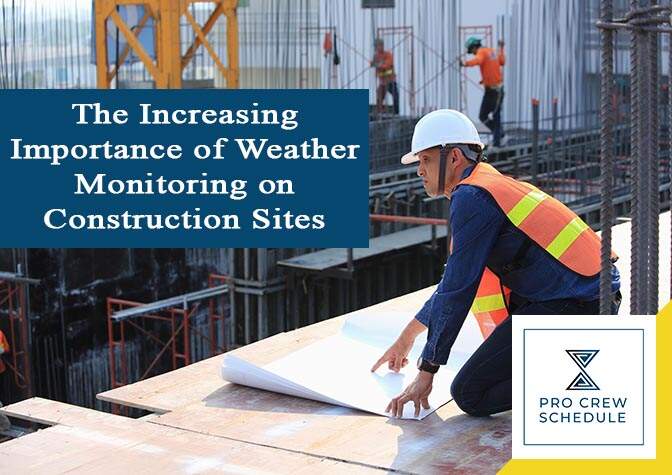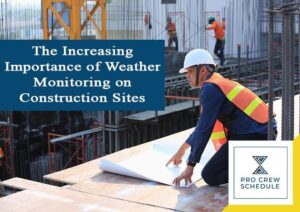Risk management is a crucial part of project management, and raging weather is among the industry’s significant risks. Construction works are often performed under the influence of various external factors, particularly the weather. Hence, contractors have to suspend any activities that can’t be completed safely, especially when weather conditions are unfavorable. The weather can’t be predicted with 100% accuracy, and also, some related conditions can change in seconds.
In fact, buildings are more vulnerable to weather conditions, especially when heavy equipment and other structural components are being installed. The weather causes many accidents like the collapsing of cranes and destroying buildings in the process. If you want to complete the project and ensure success, then the weather cannot be totally ignored.
For this article, let’s find out why weather had become a significant factor to observe at the construction site.
Understanding the Limitations of Weather Forecasts
Some projects are often managed on weather forecasts. Yet, forecasts have a very significant limitation, which is to describe the entire conditions that might be expected for a specific region. That is why checking the weather forecast even before lifting operations should be done. Though this simple solution is much better than disregarding the weather completely, forecasts also have several limitations. Take a look below:
- Weather forecasts can provide a general picture of what to be expected. Yet, it cannot predict any short-term events like raging turbulence and wind gusts.
- Modern weather forecasts are generally more accurate today than a few decades ago. However, the forecasts are not totally 100% accurate. The weather is chaotic by nature and can be immediately affected by several variables that can’t be completely analyzed.
- Site conditions can create microclimates. In fact, these microclimates are not even reflected due to weather forecasts. For instance, the wind is speeding up just when it’ll pass between two huge buildings.
Also, three types of weather data should be considered and analyzed in construction project management:
· Historical data – it is useful for planning projects that are soon to be built over a couple of months or years.
- Weather forecasts – these are suitable for any short-term planning, like scheduling weekly tasks and activities.
- Direct measurements – comes from a weather monitoring system and is used to make quick decisions and detect sudden changes.
Moreover, obtaining direct measurements is a reliable way to track the weather at the construction site. Additionally, since project managers are not expected to be present 24/7 at construction sites, using weather instruments can help them track the weather since it has remote connectivity.
Weather Monitoring as a Solution to Resolve Project Disputes
Construction contracts legally contain penalties for possible missed deadlines unless if the construction project manager can reason out and justify that the external factors caused the project delays. Weather perception is usually subjective, especially when there are no measurements taken. Thus, explaining project delays because of the weather can be a challenge for contractors.
The great thing is that issues like this can be fixed by recording wind speeds during the project’s execution. However, gusts, which are a sudden increase in wind speed, can start in seconds. It is proven to be very dangerous, particularly on construction sites. The following are some of the most common consequences.
- Causing the construction crew to lose their balance
- Affecting and damaging building elements that are presently a work in progress
- Sending most construction materials flying at higher speed
- Gusts are very unsafe when there are tower cranes involved.
- Anybody can be struck-by incidents due to many objects being blown around.
- Eye injuries can be an issue due to small particles of flying dusts and debris.
Trips, slips and falls due to workers responding to a falling object or hardhat because of increasing wind speed
But once the weather is already being monitored and tracked regularly at the construction site, working conditions become safer. Weather forecasts are assumed to provide a general outlook, yet there’s no way to predict the wind’s sudden gusts. Here are the other benefits of weather monitoring.
- Conflicts between project engineers, contractors, and project owners are prevented.
- Weather perception is often subjective. Hence, a missed deadline due to harsh weather is easy to justify for as long as there is proof.
- A weather monitoring system embedded with data storage can store a record of various weather conditions.
- By the end of the project, any missed deadlines can be clarified using the data log of unfavorable weather.
- The weather monitoring system is as consistent and functional as the weather instruments it uses.
Take note: Measuring wind direction is a critical step since risks transformed depending on the course from which the wind blows. For tower cranes, the wind’s mechanical loading effects are often determined by direction and speed. When the wind is blowing from behind, the crane tends to push the load away. It increases the swing radius, and it’ll cause a much higher bending load on the boom.
Selecting a Weather Monitoring System and Construction Schedule Software for Building Projects
Weather monitoring might sound like a costly concept, but you won’t need any scientific weather station for every project site. There are compact systems and advanced software tools that have been specifically designed for outdoor use and project management in heavy industries like construction.
- Consider the usual conditions in the construction industry. Make sure to look for the best weather monitoring device with a corrosion-proof, waterproof, and dust-tight enclosure.
- Project managers should be checking the weather data every single time. Thus, needing a device that allows remote wireless access is a priority.
- The device should also have high resistance in impact just in case if a powerful and strong wind knocks it down.
- Again, a gust of winds can happen at any time. Hence, you need a device that can send programmed notifications.
- Implementing project management for construction is critical to success when building projects. Therefore, it is very common for project leaders to consider using software tools for efficient project management.
- This cloud-based software is beneficial in each project phase. The features are specifically designed to best achieve a more efficient way of handling construction projects and crew.
- Real-time collaboration, time-tracking, and data/file storage are some of the best features this software application offers.
Highlighting the different seasons is also crucial when planning and developing a construction project. Any weather-sensitive activities must not be arranged for a single time in a year, especially when storms are expected. Otherwise, suspending work is done frequently, resulting in another project delay.
Minimizing Weather Risks with Prefabrication
Prefabrication is a clear and promising concept in the construction industry, as building modules are often assembled away from the project sites inside a controlled factory environment. Since site activities have to be suspended when the weather is harsh, prefabrication can continue despite outdoor conditions.
Prefabrication usually involves the transportation of modules to the site during assembly. However, the portion of the construction process that often happens outdoors is minimized significantly. And while the weather is still slowing down modular construction, the projects are much less vulnerable than the other using traditional construction methods.
1. Reduced Site Disruption
Since various building components are completed in the factory, there is a lesser chance of being affected by the weather. Additionally, lesser truck traffic is also one of the advantages of prefabrication. It is proven to limit disruptions caused by the weather, waste, pollution, and other common irritants. The streamlined approach to the project usually offers a better and efficient atmosphere for productivity. It also eliminates any unnecessary interferences and distractions apart from weather conditions.
2. Safety
Since sub-assemblies are often created in a factory-monitored environment using dry materials, there is a much lesser risk for issues associated with weather, moisture, and other environmental dirt and hazards. It ensures that everyone working on-site, including eventual occupants, are less likely to be exposed to weather-related health risks.
The indoor-construction environment presents fewer risks for sudden accidents and other liabilities. Also, there are strict factory procedures and processes that protect workers from on-the-job injuries. Although safety is the top priority at the construction site, every crew is still subjected to weather-related conditions, wind, and changing ground conditions.
3. Consistent Quality
Since prefabricated construction typically occurs at a controlled manufacturing area and follows specified standards, the structures’ sub-assemblies are constructed to a uniform quality. These ongoing construction for these structures will not be significantly affected by any weather risks and environmental hazards. Construction site-built structures are reliable upon various schedules of independent contractors, skill levels, and weather conditions. Also, better project results are best achieved using construction crew scheduling software.
Everything stated contributes to the overall quality and craftsmanship of any given structure. With prefabrication, every sub-assembly is being built by experienced workers, specifically at a weather-resistant factory. Multiple quality checks are executed throughout the entire process. Also, some of the components of the buildings are built using precise equipment to ensure conformity to standard building codes.
Key Takeaways
Project managers have the option of using historical weather records and weather forecasts. These two options can be used respectively for long-term and short-term planning. Yet, project leaders have to acknowledge that only direct measurements with a weather instrument can only provide reliable information in real-time.







